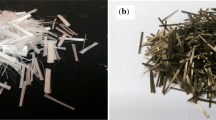Abstract
This paper presents the behavior of the interfacial bond between an innovative FRP fibre and cement mortar under time-dependent loading. Two types of FRP fibres—GFRP and CFRP were investigated. Particularly, the fibre pullout response under quasi-static loading is compared with the response under dynamic loading. To gauge the long term behavior of cracked fibre reinforced composites, fibre relaxation tests were conducted in which initial strain was imparted and sustained, and the relaxation of the composite in terms of drop in load over time period was monitored at room temperature as well as at 50 °C. FRP fibres were found to be to some extent sensitive to loading rate, with an increase in the range of 30–50% in the peak load under dynamic loading. The GFRP fibres itself depicted higher strengths under dynamic loading rate. Under a sustained fibre slip, FRP fibres showed a lower relaxation at both room temperature and at 50 °C compared to commercially available steel and polypropylene fibres. There was also no conclusive change in pullout response in specimen subjected to sustained strains compared to reference.









Similar content being viewed by others
References
Farooq M, Banthia N (2018) An innovative FRP fibre for concrete reinforcement: production of fibre, micromechanics, and durability. Constr Build Mater 177C:406–421. https://doi.org/10.1016/j.conbuildmat.2018.03.198
Banthia N, Trottier JF (1991) Deformed steel fiber-cementitious matrix bond under impact. Cem Concr Res 21:158–168. https://doi.org/10.1016/0008-8846(91)90042-G
Banthia N, Trottier J (1991) Strain rate sensitivity of fibre matrix bond. Ceram Trans 16:603–618
Gokoz UN, Naaman AE (1981) Effect of strain-rate on the pull-out behaviour of fibres in mortar. Int J Cem Compos Light Concr 3:187–202. https://doi.org/10.1016/0262-5075(81)90051-8
Banthia N (1990) A study of some factors affecting the fiber–matrix bond in steel fiber reinforced concrete. Can J Civ Eng 17:610–620. https://doi.org/10.1139/l90-069
Abu-Lebdeh T, Hamoush S, Zornig B (2010) Rate effect on pullout behavior of steel fibers embedded in very-high strength concrete. Am J Eng Appl Sci 3:454–463
Kim DJ, El-Tawil S, Naaman AE (2008) Loading rate effect on pullout behavior of deformed steel fibers. ACI Mater J 105:576–584
Xu M, Hallinan B, Wille K (2016) Effect of loading rates on pullout behavior of high strength steel fibers embedded in ultra-high performance concrete. Cem Concr Compos 70:98–109. https://doi.org/10.1016/j.cemconcomp.2016.03.014
Bindiganavile V, Banthia N (2001) Polymer and steel fiber-reinforced cementitious composites under impact loading—part 1: bond-slip response. ACI Mater J 98:17–24
Bhutta A, Farooq M, Borges PHR, Banthia N (2018) Influence of fiber inclination angle on bond-slip behavior of different alkali-activated composites under dynamic and quasi-static loadings. Cem Concr Res 107:236–246. https://doi.org/10.1016/j.cemconres.2018.02.026
Tai YS, El-Tawil S, Chung TH (2016) Performance of deformed steel fibers embedded in ultra-high performance concrete subjected to various pullout rates. Cem Concr Res 89:1–13. https://doi.org/10.1016/j.cemconres.2016.07.013
Boshoff WP, Mechtcherine V, van Zijl GPAG (2009) Characterising the time-dependant behaviour on the single fibre level of SHCC: part 2: the rate effects on fibre pull-out tests. Cem Concr Res 39:787–797. https://doi.org/10.1016/j.cemconres.2009.06.006
Nieuwoudt PD, Boshoff WP (2017) Time-dependent pull-out behaviour of hooked-end steel fibres in concrete. Cem Concr Compos 79:133–147. https://doi.org/10.1016/j.cemconcomp.2017.02.006
Babafemi AJ, Boshoff WP (2017) Pull-out response of macro synthetic fibre from concrete matrix: effect of loading rate and embedment length. Constr Build Mater 135:590–599. https://doi.org/10.1016/j.conbuildmat.2016.12.160
Banthia N, Krishnadev MR (1990) Steel-fiber cementitious matrix load relaxation studies using a screw-driven testing machine. Exp Tech 14:41–43
Banthia N, Pigeon M (1989) Load relaxation in steel fibres embedded in cement matrices. Int J Cem Compos Light Concr 11:229–234. https://doi.org/10.1016/0262-5075(89)90103-6
Babafemi AJ, Boshoff WP (2015) Tensile creep of macro-synthetic fibre reinforced concrete (MSFRC) under uni-axial tensile loading. Cem Concr Compos 55:62–69. https://doi.org/10.1016/j.cemconcomp.2014.08.002
Abrishambaf A, Barros JAO, Cunha VMCF, Frazão C (2017) Time dependent behaviour of fibre pull-out in self-compacting concrete. Cem Concr Compos 77:14–28. https://doi.org/10.1016/j.cemconcomp.2016.12.004
Kim DJ, El-Tawil S, Naaman AE (2009) Rate-dependent tensile behavior of high performance fiber reinforced cementitious composites. Mater Struct 42:399–414. https://doi.org/10.1617/s11527-008-9390-x
Kanda T, Li VC (1998) Interface property and apparent strength of high-strength hydrophilic fiber in cement matrix. J Mater Civ Eng 10:5–13. https://doi.org/10.1061/(ASCE)0899-1561(1998)10:1(5)
Naaman AE, Namur G, Najm H, Alwan J (1989) Bond mechanisms in fiber reinforced cement-based composites
Shokrieh MM, Omidi MJ (2009) Tension behavior of unidirectional glass/epoxy composites under different strain rates. Compos Struct 88:595–601. https://doi.org/10.1016/j.compstruct.2008.06.012
Naik NK, Yernamma P, Thoram NM et al (2010) High strain rate tensile behavior of woven fabric E-glass/epoxy composite. Polym Test 29:14–22. https://doi.org/10.1016/j.polymertesting.2009.08.010
Yoo DY, Kim S (2019) Comparative pullout behavior of half-hooked and commercial steel fibers embedded in UHPC under static and impact loads. Cem Concr Compos 97:89–106. https://doi.org/10.1016/j.cemconcomp.2018.12.023
Acknowledgements
The authors gratefully acknowledge the support received from the Composites Research Network of the Materials Engineering Department at the University of British Columbia. The authors are also grateful for the financial support received from the Tricon Concrete Finishing Company and the Natural Sciences and Engineering Research Council of Canada (NSERC). As well, we wish to show our gratitude for the support given us by the Canada-India Research Centre of Excellence (IC-IMPACTS).
Author information
Authors and Affiliations
Corresponding author
Ethics declarations
Conflict of interest
The authors have no conflict of interest.
Additional information
Publisher's Note
Springer Nature remains neutral with regard to jurisdictional claims in published maps and institutional affiliations.
Rights and permissions
About this article
Cite this article
Farooq, M., Banthia, N. FRP fibre-cementitious matrix interfacial bond under time-dependent loading. Mater Struct 52, 109 (2019). https://doi.org/10.1617/s11527-019-1409-y
Received:
Accepted:
Published:
DOI: https://doi.org/10.1617/s11527-019-1409-y




